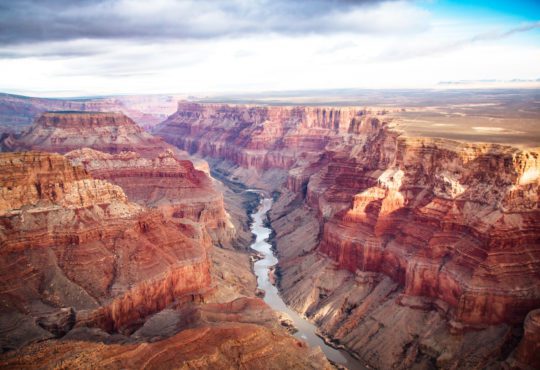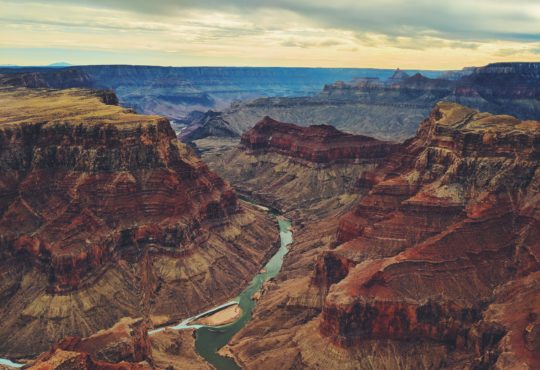
Many people shy away from visiting national parks in winter. It can be cold and snowy. Additionally, some amenities are not fully operational or are closed altogether. However, visiting the Grand Canyon, in particular, during the winter time can be one of the best times to visit.
Contents
- 1 How are the crowds during the winter?
- 2 Is it too cold to visit the Grand Canyon in winter?
- 3 Are some parts of the Grand Canyon closed in winter?
- 4 Will accommodations be open in winter?
- 5 Are there additional ways to see the canyon in winter if the weather is not ideal?
- 6 Can you hike into the Grand Canyon in winter?
How are the crowds during the winter?
You have probably guessed that the Grand Canyon doesn’t draw a big crowd in winter, and you are right. In fact, only 10% of the yearly visits are in winter. In December, January and February of 2022, a little over 600,000 people visited the Grand Canyon. Comparatively, 1 million visitors cross the gates some of the summer months. This is a huge difference. However, just because there aren’t as many people going to the Grand Canyon in winter, doesn’t mean this isn’t a time worth visiting. There is plenty to do and see and the park is beautiful in winter.
Is it too cold to visit the Grand Canyon in winter?
The most visited entrance of the Grand Canyon, the South Rim has an elevation of 7,000 feet. This means it will be cold in the winter but not “ice box” cold. Temperatures are usually in the mid to high forties in the daytime and in the twenties at night. The South Rim gets snow as well, at about 60 inches a year. But, the snow does not stay around long and usually melts within a day or two.
When you are hiking and moving around during the day in clothes that are fit for the climate, being in the Grand Canyon and seeing the sights in winter time weather is pleasant and enjoyable.
If it does snow, the contrast of the white snow against the beautiful reds, oranges, purples and pinks of the canyon is a sight to see. The air is cleaner and clearer and the visibility is better than in summer. You can see for miles more in the winter because the air pollution and haziness is lessened in winter.

Are some parts of the Grand Canyon closed in winter?
There are closures of parts of the Grand Canyon in winter. The South Rim’s elevation is at 7,000 feet, therefore it gets a fair amount of snow. Any snow that does fall tends to melt quickly due to average daytime highs being above freezing. However, the North Rim is even higher at 8,800 feet. This enables much more snow and ice to accumulate, resulting in the closure of the operations and maintenance of roads to the North Rim.
The only way to enjoy this area is to hike or snowshoe on the trails leading from the South Rim or to travel by foot from Jacob’s Lake, which is 45 miles away. Either way, you will need a backcountry permit. No facilities or amenities are open.
Will accommodations be open in winter?
At the South Rim, all lodges, hotels and cabins are open for business. You will also have your pick of accommodations due to low demand at this time of year.
This also means that rates are considerably lower than at other times such as the peak of summer and spring break. This is a great time to stay inside the park and enjoy discounted rates. At many of the lodges and hotels you can enjoy up to 40 percent off of what you would pay in summer. This means putting that saved money towards tours or a nice dinner at the El Tovar!
Are there additional ways to see the canyon in winter if the weather is not ideal?
If you happen to book a trip when there is a snow storm and don’t feel comfortable driving the plowed roads, there are additional ways to see the canyon.
Shuttle Service
The Village and Kaibab routes are available during the winter so that you can see all the viewpoints of the canyon without having to worry about the safety of driving a car in inclement weather. The Hiker’s Express bus will also run it’s normal route to the South Kaibab Trailhead for the convenience of hikers.
If you still would like to drive the rim on your own, you’re in luck! The Hermit Road Shuttle does not run during the winter, therefore, you can drive down the road and see the sights yourself. This option is not available in warmer months, so this is a unique opportunity. You should take proper care and precautions when driving on snow packed roads and be prepared in the event that you need help.
Take the train
The Grand Canyon Railway is an amazing way to see the canyon in all its winter white splendor in safety and comfort. Since 1901, the Grand Canyon Railway has been taking passengers into one of the seven wonders of the world while entertaining them along the way.
The train excursions lasts about 4.5 hours and will leave you a forever fan for not only nature, but the secrets of the Grand Canyon itself. This is also a perfect opportunity to to see the inside of the canyon while blanketed in its winter white, a rare opportunity unless taking the train.

Take a helicopter tour
Another fabulous way to see the canyon is to take a helicopter tour. There are many companies that offer this great way to see America’s favorite national park. You can choose tours that can be as short as twenty minutes or as long as seven hours.
The seven hour tour includes multiple modes of transportation that starts in Las Vegas. From there, you will take an airplane that will show you the sights Lake Mead and Hoover Dam. Then, you’ll enjoy a helicopter ride to the bottom of the Grand Canyon, where you’ll then take a boat ride on the Colorado River. Talk about an adventure!
Can you hike into the Grand Canyon in winter?
Hiking into the Grand Canyon in winter can be the best time to do so. While the temperature may be in the forties around the rim, the canyon will be very pleasant and can be near 60 degrees. There are three trails that may be good options for hiking in winter from the South Rim.
Rim Trail
The Rim Trail is the best choice for hikers that want to avoid the sometimes treacherous conditions that can be experienced on other trails. The Rim Trail winds along the edge of the great crevasse for 13 miles. You can see many great viewpoints along this route and because it is winter, you will have many of those points virtually to yourself.
Bright Angel Trail
The Bright Angel Trail will descend into the canyon and should only be attempted with proper planning and equipment. Because the trail is north facing, there is often snow and ice for the first three miles. This can be quite dangerous if you are not careful. You may want to consider traction devices for your shoes so you won’t plummet to the bottom of the canyon.
As you descend, the temperatures will warm and the snow and ice dissipate. Be sure to look at weather forecasts, dress appropriately and if you are hiking to the bottom of the canyon, plan for any unforeseen events.
South Kaibab Trail
The South Kaibab Trail gets more sun exposure than the Bright Angel Trail so the snow and ice aren’t as prevalent. You should still prepare for cold weather and the potential for ice, as the most recent snowstorm may have been the night before. The campground at the bottom of the canyon is also almost twice as far as the one on the Bright Angel Trail, so prepare for a longer hike if you will be camping at the bottom.
The Grand Canyon is an incredible place to be in winter. The angle of the sun and the snow on the canyon makes for incredible sunrises, sunsets and the photo opportunities are priceless. Visiting the Grand Canyon isn’t just a great idea, but should be on everyone’s list for a vacation experience.







